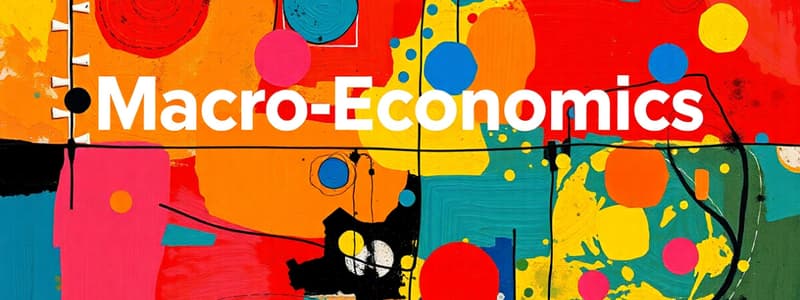Podcast
Questions and Answers
What does Gross Domestic Product (GDP) specifically measure in an economy?
What does Gross Domestic Product (GDP) specifically measure in an economy?
- The total value of goods and services produced over a specific period. (correct)
- The average income level of the population in a given country.
- The overall level of unemployment and inflation in the economy.
- The total level of government spending and taxation decisions.
Which of the following statements best defines 'Comparative Advantage'?
Which of the following statements best defines 'Comparative Advantage'?
- The ability of a country to produce goods at a lower opportunity cost than others. (correct)
- The ability of a country to produce goods at a higher price than others.
- A country's capacity to produce all goods with equal efficiency.
- The practice of restricting imports to boost domestic production.
Which of the following is a primary focus of microeconomics?
Which of the following is a primary focus of microeconomics?
- Aggregate economic growth and national income levels.
- Government intervention in monetary policy.
- International trade relations and exchange rates.
- Individual consumers and their decision-making processes. (correct)
Which economic theory emphasizes the role of government intervention in managing economic fluctuations?
Which economic theory emphasizes the role of government intervention in managing economic fluctuations?
Which of the following is NOT a part of fiscal policy?
Which of the following is NOT a part of fiscal policy?
Which market structure is characterized by a single seller with significant market power?
Which market structure is characterized by a single seller with significant market power?
What concept describes the preference for avoiding losses rather than acquiring equivalent gains?
What concept describes the preference for avoiding losses rather than acquiring equivalent gains?
Which of the following best defines heuristics in economic decision-making?
Which of the following best defines heuristics in economic decision-making?
Supply-side economics primarily argues that economic growth can be stimulated by which of the following actions?
Supply-side economics primarily argues that economic growth can be stimulated by which of the following actions?
What is meant by the term 'bounded rationality' in behavioral economics?
What is meant by the term 'bounded rationality' in behavioral economics?
Study Notes
Macroeconomics
- Definition: Study of the economy as a whole; focuses on aggregate changes and overall economic performance.
- Key Concepts:
- Gross Domestic Product (GDP): Total value of all goods and services produced in a country over a specific period.
- Inflation: Rate at which the general level of prices for goods and services is rising, eroding purchasing power.
- Unemployment: Measurement of the number of people actively seeking work but unable to find jobs.
- Fiscal Policy: Government spending and taxation decisions aimed at influencing economic activity.
- Monetary Policy: Central bank actions (like interest rate changes) that influence money supply and credit.
Microeconomics
- Definition: Study of individual consumers and businesses; focuses on supply and demand in specific markets.
- Key Concepts:
- Demand and Supply: Basic economic model describing how prices are determined in a market.
- Elasticity: Measure of responsiveness of quantity demanded or supplied to price changes.
- Market Structures:
- Perfect Competition: Many buyers/sellers; homogeneous products.
- Monopoly: Single seller dominating the market; price maker.
- Oligopoly: Few sellers; market power shared among them.
- Consumer Behavior: How individuals make decisions based on preferences, income, and prices.
International Trade
- Definition: Exchange of goods and services across national borders.
- Key Concepts:
- Comparative Advantage: Ability of a country to produce goods at a lower opportunity cost than others.
- Trade Barriers: Tariffs, quotas, and regulations that countries use to control the amount of trade across their borders.
- Balance of Trade: Difference between the value of a country's exports and imports.
- Trade Agreements: Treaties between countries to facilitate trade (e.g., NAFTA, EU).
- Exchange Rates: Value of one currency in relation to another, affecting international trade dynamics.
Economic Policy
- Definition: Actions taken by the government to influence its economy.
- Key Concepts:
- Monetary Policy: Central bank control of the money supply and interest rates.
- Fiscal Policy: Government's use of spending and taxation to influence the economy.
- Regulatory Policies: Rules established to control economic activities and maintain market integrity.
- Supply-Side Economics: Theory that economic growth can be most effectively fostered by lowering taxes and decreasing regulation.
- Keynesian Economics: Advocates for active government intervention to manage economic cycles.
Behavioral Economics
- Definition: Study of psychological and social factors influencing economic decision-making.
- Key Concepts:
- Heuristics: Mental shortcuts that simplify decision-making processes.
- Framing Effect: People's decisions are influenced by how choices are presented.
- Loss Aversion: Tendency to prefer avoiding losses over acquiring equivalent gains.
- Nudges: Small changes in the way choices are presented that can significantly alter behavior.
- Bounded Rationality: Concept that individuals are limited in their decision-making capabilities due to cognitive limitations and time constraints.
Macroeconomics
- Study of the entire economy, analyzing aggregate changes in economic indicators and overall performance.
- Gross Domestic Product (GDP) represents the total value of all goods and services within a nation's borders over a certain period, critical for measuring economic activity.
- Inflation reflects the rate at which prices are rising, which can diminish purchasing power and affect consumer behavior.
- Unemployment quantifies the individuals actively seeking employment who are unable to find work, indicating labor market health.
- Fiscal Policy involves government strategies for spending and taxation to stimulate or slow down economic growth.
- Monetary Policy refers to central bank strategies, such as altering interest rates, aimed at controlling the money supply and influencing economic conditions.
Microeconomics
- Focuses on individual consumers and businesses, analyzing their behaviors and market interactions.
- Demand and Supply inform the foundational model of price determination in various markets through their interactions.
- Elasticity measures how sensitive the demand or supply of goods is to price changes, influencing pricing strategies.
- Market Structures include:
- Perfect Competition: Characterized by many sellers and buyers with identical products, ensuring a fair market.
- Monopoly: A market with a single seller, allowing control over prices with no viable competition.
- Oligopoly: A small number of sellers dominate the market, resulting in shared market power and potential collusion.
- Consumer Behavior analyses decision-making processes based on preferences, income constraints, and product prices.
International Trade
- Involves the trade of goods and services between countries, enhancing economic interdependence.
- Comparative Advantage enables countries to specialize in the production of goods at a lower opportunity cost, fostering trade efficiency.
- Trade Barriers include tariffs and quotas, which governments utilize to regulate imported and exported goods, impacting trade volume.
- Balance of Trade measures the economic difference between a nation's exports and imports, indicating economic strength.
- Trade Agreements promote lasting economic partnerships and facilitate smoother trade conditions, exemplified by treaties such as NAFTA and the EU.
- Exchange Rates define the value ratio of one currency to another, influencing global trade transactions dramatically.
Economic Policy
- Encompasses government initiatives aimed at managing economic activity and addressing economic challenges.
- Monetary Policy plays a crucial role in regulating the economy through adjustments in the money supply and interest rates.
- Fiscal Policy entails government adjustments in spending and taxation to achieve macroeconomic goals, such as economic stability.
- Regulatory Policies set forth by governments aim to create a fair operating environment, ensuring market efficiency and consumer protection.
- Supply-Side Economics emphasizes growth by reducing taxes and regulation, advocating for freer market dynamics.
- Keynesian Economics supports proactive government intervention to mitigate economic downturns and stabilize growth cycles.
Behavioral Economics
- Investigates the impact of psychological and social influences on economic decision-making processes.
- Heuristics function as mental shortcuts that help individuals make swift decisions without exhaustive analysis.
- Framing Effect shows that the presentation of choices can manipulate consumer decisions and perceptions.
- Loss Aversion explains the tendency of individuals to prefer avoiding losses over making comparable gains, leading to risk-averse behavior.
- Nudges are minor adjustments in choice architecture that can significantly shape outcomes and promote beneficial decision-making.
- Bounded Rationality acknowledges the limitations of individuals' decision-making capabilities due to cognitive constraints and time pressures.
Studying That Suits You
Use AI to generate personalized quizzes and flashcards to suit your learning preferences.
Description
This quiz covers essential concepts of macroeconomics and microeconomics. It includes key topics such as GDP, inflation, and fiscal policy, as well as demand and supply dynamics. Perfect for students looking to solidify their understanding of economic principles.




